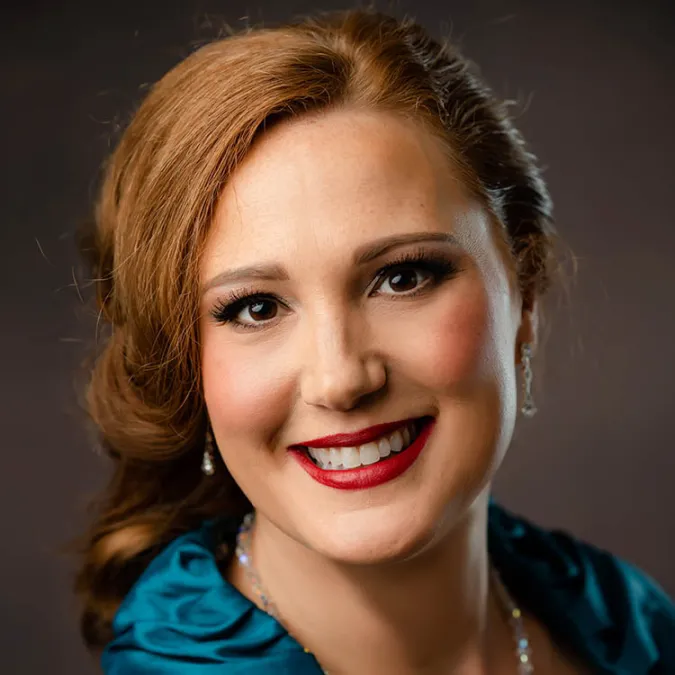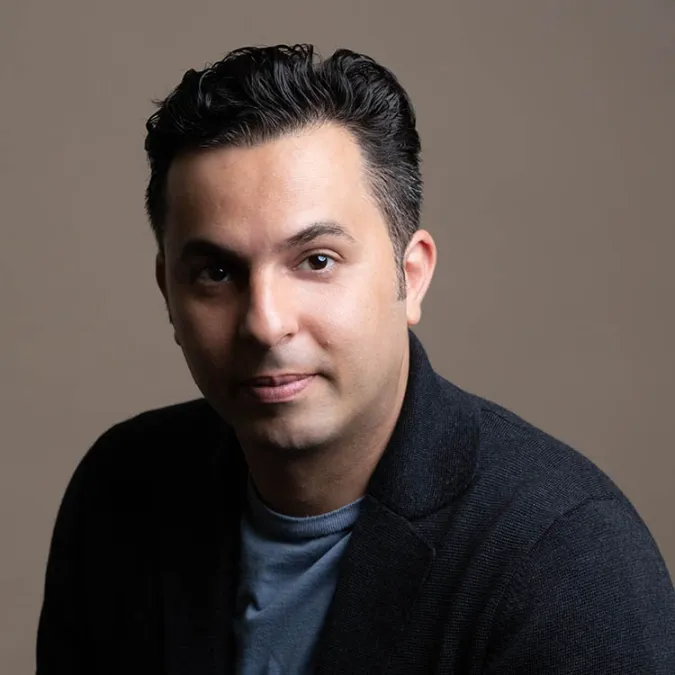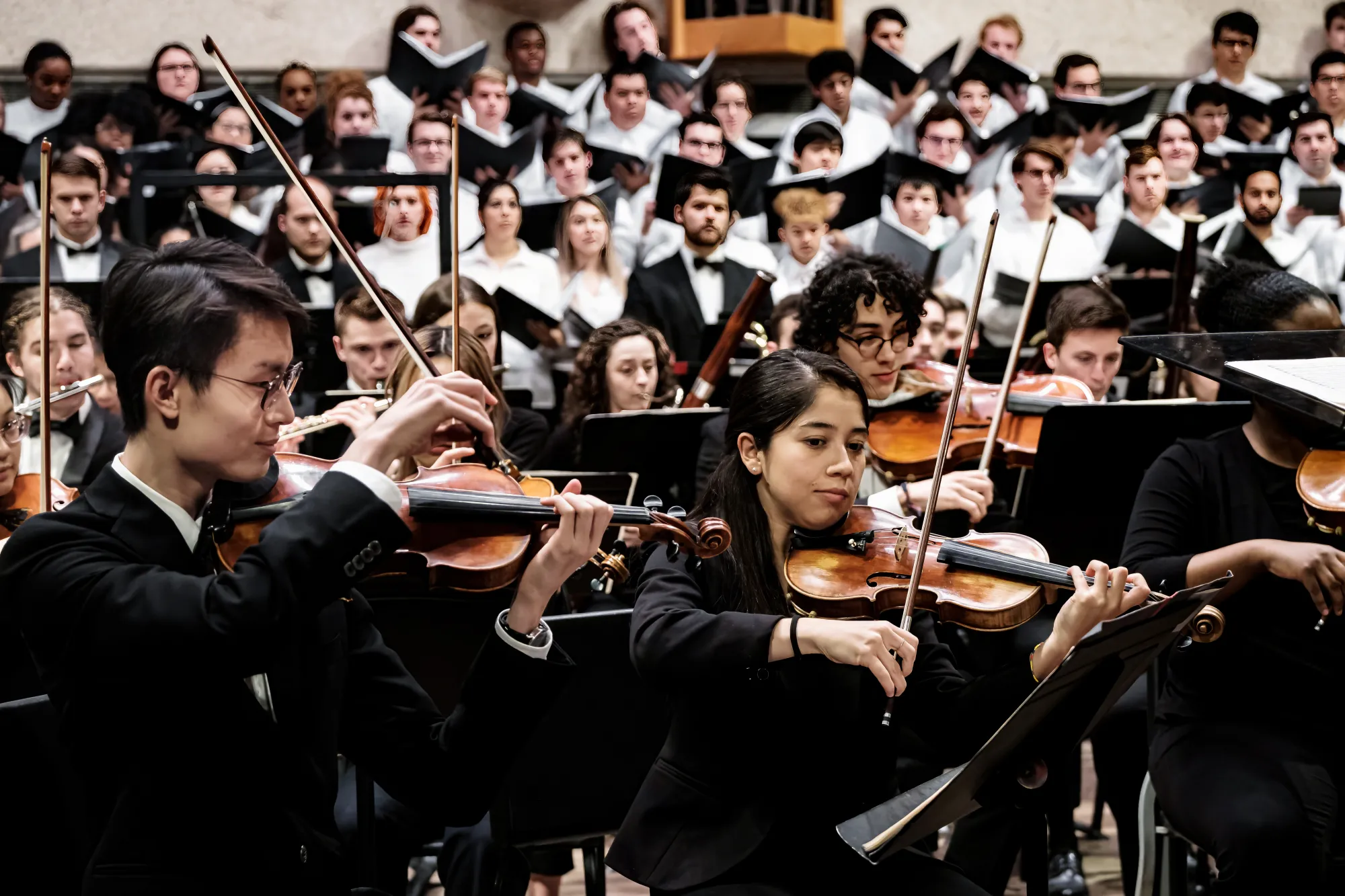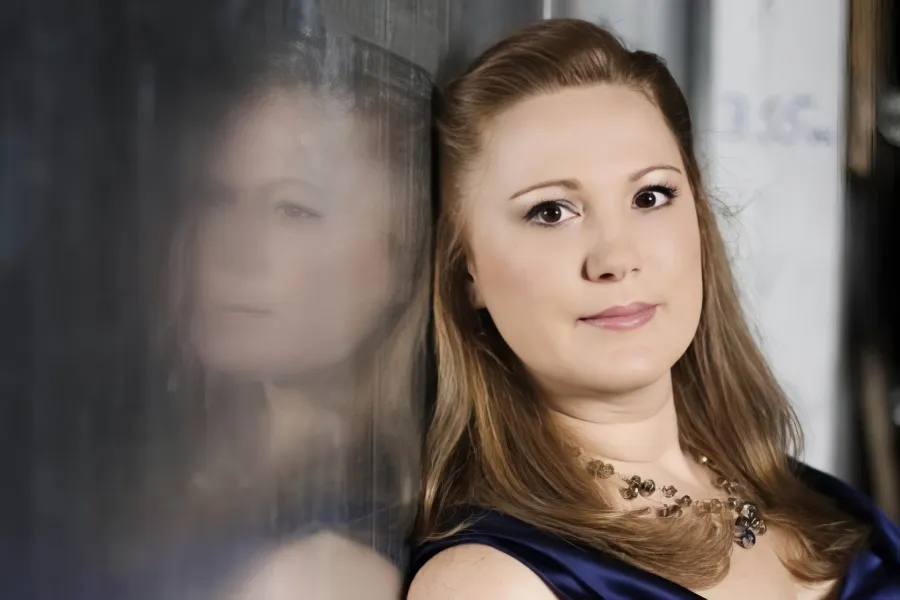Farkhad Khudyev, conductor
Rebecca Davis, soprano
This concert will last about one hour minutes with one intermission.
Please silence your electronic devices.
Photography, video, or recording of any part of this performance is prohibited
Program
Richard Strauss
ed. Pfefferkorn
Don Juan, TrV 156, op. 20
Guiseppi Verdi
Ave Maria (Act IV) from Otello
Rebecca Davis, soprano
Richard Wagner
Liebestod “Mild und leise” from Tristan und Isolde, WWV 90
Rebecca Davis, soprano
intermission
Ottorino Respighi
Pines of Rome, P.141
I. I pini di Villa Borghese (The Pines of the Villa Borghese)
II. Pini presso una catacomba (Pines Near a Catacomb)
III. I pini del Gianicolo (The Pines of the Janiculum)
IV. I pini della Via Appia (The Pines of the Appian Way)
About the Program
Program notes by Mark Bilyeu
Richard Strauss
Don Juan, Op. 20
Born June 11, 1864, Munich, Germany
Composed1888
Premiered November 11, 1889, Weimar Opera Orchestra, Germany, Richard Strauss, conductor
Duration 20 minutes
In 1888, a 24 year old Richard Strauss came across Nikolaus Lenau’s poem Don Juan. The work was a derivative of the legend dating back to the 16th century, but as Lenau wrote “My Don Juan is no hot-blooded man eternally pursuing women [editor’s note: he was]. It is the longing in him to find a woman who is to him incarnate womanhood, and to enjoy, in the one, all the women on earth whom he cannot possess as individuals [editor’s note: red flag].” The 24 year old Strauss was enamored, and took to writing a narrative orchestral work depicting these adventures: a musical form he would come to dominate throughout the course of his life known as a tone poem. Through the 20 minute virtuosic tour-de-force for every musician on stage, we experience the full trajectory of Don Juan’s pursuits: he bursts onto the scene with a flourish, meeting his love interests in dreamy solo passages (the oboe gets all the good stuff) which are always interrupted by more of his brash restlessness. You’ll hear four iterations of his main theme before he gives up on his attempts to find the perfect woman. In Lenau’s version, when Don Juan is unable to find his ideal woman, he allows himself to be killed in a duel, saying “My deadly foe is in my power, and this, too, bores me, as does life itself.” The work ends with the nobleman breathing his last breaths as the orchestra pulses three last pianissimo chords.
Giuseppe Verdi
Ave Maria from Othello
Born October 10, 1813, Le Roncole, Italy
Died January 27, 1901, Milan, Italy
Composed 1884-1887
Premiered February 5, 1887, Teatro alla Scala, Milan, Italy
Duration 5 minutes
“He is one of my very special poets,’ wrote Giuseppe Verdi about William Shakespeare, “and I have had him in hand since my earliest youth, and I read and re-read him continually.” It is no surprise that of Verdi’s 28 operas, three of the best-known originated from his favorite poet: Falstaff, MacBeth, and his 1887 Otello. Along with his long-term artistic partner, the librettist/composer Arrigo Boito, Verdi crafted a rendering of Otello that eliminated many characters, flattened Iago into a super-villian, and elevated Desdemona into an autonomous heroine who the musicologist Joseph Kerman described as “capable of adultery as she is of passion in the grand manner. Her religiosity, true to this conception, is constant...” The opening of Act 4 is carried solely by Desdemona as she prepares for bed. She offers the Bard’s famous “Willow Song,” and continues with her evening prayers — complete with an ‘Ave Maria’ that seems to stop time in its tracks. This addition to the scene (there was no Blessed Virgin in Shakespeare’s play) was no doubt for Verdi’s Catholic fans, as Verdi’s wife described him as “not much of a believer, even an atheist.” The petition concludes with “pray for us at the hour of our death” as Otello himself enters her bedchamber.
Richard Wagner
Liebestod from Tristan und Isolde
Born May 22, 1813, Leipzig, Germany
Died February 13, 1883, Venice, Italy
Composed 1859
Premiered January 25, 1860, Paris, France
Duration 17 minutes
“Not to mince words,” wrote a critic for the German paper Allgemeine musikalische Zeitungit, [Tristan und Isolde] is the glorification of sensual pleasure, tricked out with every titillating device…the most ideal of the Muses has been made to grind the colors for indecent paintings… Wagner makes sensuality itself the true subject of his drama, we think that the stage presentation of the poem Tristan und Isolde amounts to an act of indecency.” Richard Wagner couldn’t have been more pleased with this public denouncement of his work. Even in his lifetime, Wagner was seen as a composer pushing the limits of sound and senses, and his opera featuring the fated destiny of these enemies-turned-lovers via a magic potion was a dramatic and sensory overload of the highest order. In the opening of the opera, Wagner depicted the unresolved nature of their story with what would come to be called the “Tristan Chord” (that is, a uniquely-spelled half-diminished seventh chord, for those counting half steps at home). This dissonance — or discomfort — was present throughout the opera, and became famous for its inherent ambiguity as to where it should resolve — or how it might become comfortable. It isn’t until the final moments of the three-act opera, the Liebestod, that Wagner finally offers us, and the lovers, a resolution to their distress: “Love-Death.” While the knight Tristan lies dying after being stabbed by the footman of Isolde’s husband, Isolde falls over his body, a sense of unity and completion washing over her as she is swept away in “the vast wave of the world’s breath.”
Ottorino Respighi
Pines of Rome
Born July 9, 1879, Bologna
Died April 18, 1936, Rome
Composed 1923-24
Premiered December 14, 1924. Bernardino Molinari led the Augusteo Orchestra, in Rome
Duration 23 min
Italian composer Ottorino Respighi composed his blockbuster Roman Trilogy over the course of twelve years. His education and early career took him to Russia where he studied with composer and master orchestrator Rimsky-Korsakov for a brief stint while working as the principal violinist at the Russian Imperial Theatre, returning to Italy for a teaching position at the St. Cecilia Conservatory of Music in Rome in 1913. Though he was briefly captivated with the radical music of French modernism, he ultimately retreated to a style which was more conservative, leaning on the lush orchestrations he learned in Russia while honoring the Italian music of the distant past. With the success of his 1916 Fountains of Rome, he began composing the Pines of Rome. The composer sent along these notes for the American premiere by the New York Philharmonic: “While in his preceding work, Fountains of Rome, the composer sought to reproduce by means of tone an impression of nature, in Pines of Rome he uses nature as a point of departure, in order to recall memories and vision. The centuries-old trees which so characteristically dominate the Roman landscape become witnesses to the principal events in Roman life.” The following depictions of the movements are also given by the composer:
The Pines of the Villa Borghese: Children are at play in the pine groves of the Villa Borghese, dancing the Italian equivalent of “Ring around a Rosy.” They mimic marching soldiers and battles. They twitter and shriek like swallows at evening, coming and going in swarms. Suddenly the scene changes.
The Pines Near a Catacomb: We see the shadows of the pines, which overhang the entrance of a catacomb. From the depths rises a chant, which echoes solemnly, like a hymn, and is then mysteriously silenced.
The Pines of the Janiculum: There is a thrill in the air. The full moon reveals the profile of the pines of Gianicolo’s Hill. A nightingale sings.
The Pines of the Appian Way: Misty dawn on the Appian Way. The tragic country is guarded by solitary pines. Indistinctly, incessantly, the rhythm of unending steps. The poet has a fantastic vision of past glories. Trumpets blare, and the army of the Consul bursts forth in the grandeur of a newly risen sun toward the Sacred Way, mounting in triumph the Capitoline Hill.
About the Artists
Rebecca Davis

Lyric soprano Rebecca Davis, is known for her brilliant and warm vocal timbre, as well as dynamic vocal versatility and remarkable vocal extension. Her voice has been characterized as “powerful, majestic, captivating, elegant, and thrilling to the bone”. Some of Rebecca’s most notable appearances include her Chicago Symphony Orchestra debut singing Salaambo’s aria from Citizen Kane and appearances at Carnegie Hall singing with Mid America Productions and the American Symphony Orchestra in Mahlers' 8th symphony. Rebecca is known for her versatile role portrayals and is happy to have sung many iconic roles, such as Violetta in La Traviata, Donna Anna in Don Giovanni, Mimi in La Bohėme, Rusalka and Madama Butterfly. Ms. Davis currently resides in Germany, where she performed at the Hannover State Opera before beginning her freelance career in Europe. This season, she will appear with Musiktheater im Revier, as Franca in The Light in the Piazza, and Erste Dame in Die Zauberflöte. She will also sing the Rossini Stabat Mater with the Neue Philharmonie Westfalen as well as reprise her role as 2. Blumenmädchen in Parsifal at the Goetheanum in Switzerland. Ms. Davis is the founder of SoftlyLoud Artist Consulting, and serves as co-director for the Zenith Opera Competition.
Farkhad Khudyev

Farkhad Khudyev is the winner of the Gold Medal “Beethoven 250” at the 1st International Arthur Nikisch Conducting Competition; the Solti Foundation US 2018 and 2022 Career Assistance Award; the Best Interpretation Prize at the 1st International Taipei Conducting Competition; the 3rd prize at the 8th International Sir Georg Solti Conducting Competition; and the Gold Medal/Grand Prize at the 2007 National Fischoff Competition. Khudyev has worked with orchestras worldwide including the London Philharmonic Orchestra, Frankfurt Radio Symphony Orchestra, Frankfurt Opera Orchestra, Danish National Symphony Orchestra, Seattle Symphony, Dallas Symphony, Los Angeles Philharmonic, San Diego Symphony, Monterey Symphony, George Enescu Philharmonic Orchestra, Xi’an Symphony Orchestra and the State Taipei Chinese Orchestra. Farkhad was born in Turkmenistan, where he studied at the State Music School for gifted musicians, and then completed his studies at Interlochen Arts Academy, Oberlin Conservatory and Yale University. Khudyev serves as the Music Director of the University of Texas Symphony Orchestra in Austin, and the Orchestral Institute at the Hidden Valley Institute of the Arts in Carmel, California.
Symphony Orchestra
Violin 1
Yida An, concertmaster
Zichuan Wang
Yusong Zhao
Brandon Garza
Zi Wang
Wells Gjerlow
Suhaas Patil
Jimmy Shim
Peter Kim
Noah Briones
Ivan Arras Morales
Sui Shimokawa
Violin 2
Chloe Yofan, principal
Mei Liu
Shijie Li
Kai Lindsey
Jordan Bartel
Georgia Halverson
Yvonne Ma
Pedro Salas
Alice Pak
Cole Kai
Leiana Campanaro
Viola
Liam Cao, principal
Thomas Gougeon
Harrison Knight
Cecilia Nguyen
Kyle Adams
Gewndolyn Lay
Jackie Shim
Grace Dias
Cello
Katsuaki Arakawa, principal
Javy Liu
Seungyeon Oh
William Pu
Aidan Bolding
Christopher Tran
Wesley Fu
Arturo Gonzalez
Zachary Houlton
Kyra Hong
Bass
William Penn, principal
Andres Hernandez
Kaitlyn Ruiter
Eddie Otto
Xingchang Ye
Jewelie Lujan
Ema Deguchi-Kelly
Natalia Guerra
Lydia Chen
Flute
Gianna Baker3
Juan Fajardo1
Mercedes Gomez2
Oboe
Lademi Davies
Rachel Marquez, principal
Noah O’Brien
Clarinet
Maja Pechanach1
Matthew Rockwell3
Alayna Rosas2
Bassoon
George Alazar1
Ally Rogers2
Tucker Van Gundy3
Horn
Stephanie Chiang2
Maggie Euscher
Cheryll Huddleston
Austin Waldbusser1
Tsai-Chen Wu3
Trumpet
Harmon Byerly2
William Paladino1
Americo Zapata3
Anthony Rowan*
Jax Latham*
Anthony Ramirez*
Aiden Spicer*
Trombone
Carlos Garcia1,2
Eric Garcia
Joshua Stout3
Euphonium
Miguel Gonzalez*
Henry Otts*
Tuba
Ethyn Evans
Percussion
Matt Garcia
Marcus Alvarado
Aaryn Avila
Ashley Hsu
Sean Simpson
Clinton Washington
Harp
Tate Ahmann1
Hannah Beeler2
Keyboard
Xiaoyi Lin
Organ
Soojin Kim
Principals
1. Strauss
2. Wagner
3. Respighi
*denotes offstage brass for Pines of Rome
Upcoming Events

Mahler Symphony No. 2, Resurrection
Symphony Orchestra & Combined Choirs
Leah Crocetto, soprano
Sophio Dzidziguri, mezzo soprano
One of the most beloved symphonies in the canon, Mahler's "Resurrection" symphony boasts a large orchestra, mezzo and soprano soloists, and similarly to Beethoven's 9th Symphony, a large choir in the final movement. For this performance, the Butler School's Concert Chorale and University Chorus ensembles will join forces; they will be joined by Butler School alumni singers and community choral singers from around Austin.
Tuesday, March 31, 8:00 p.m.
Long Center for the Performing Arts
UNIVERSITY ORCHESTRA
Tuesday, October 7, 7:30 p.m.
Bates Recital Hall
SYMPHONY ORCHESTRA
Wednesday, October 15, 7:30 p.m.
Bates Recital Hall
SYMPHONY ORCHESTRA
Saturday, November 8, 7:30 p.m.
Bates Recital Hall
UNIVERSITY ORCHESTRA
Tuesday, November 18, 7:30 p.m.
Bates Rectial Hall
Event Details
$5 – 15
All University of Texas at Austin students are allowed one free ticket as long as they are available. Student tickets must be picked up at the Box Office with valid student I.D. Seating is unassigned.
If you are a patron with specific seating needs, please email tickets@mail.music.utexas.edu and we will reserve ADA seating for you.


